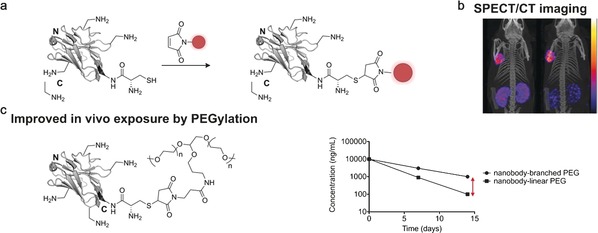Figure 8.

Nanobody functionalization through labelling of unpaired cysteine residues. a) Nanobodies do not possess free cysteine residues. Therefore, incorporating a single cysteine residue into a nanobody (mostly to the C terminus) is an easy way to site‐specifically attach a probe or drug through cysteine‐selective chemistry (shown for a maleimide‐functionalized probe). b) A prostate cancer specific nanobody (antigen PSMA) containing a C‐terminal unpaired cysteine was site‐specifically functionalized with a radiolabel by the use of maleimide chemistry. Single‐photon emission computed tomography (SPECT)/CT images of mice bearing prostate cancer tumors in the left shoulder were taken 3 h (left) and 24 h (right) after injection of the nanobody. Scale from 0 to 0.015 kBq (left) and 0 to 0.005 kBq (right).75a c) A tumor necrosis factor alpha (TNF) nanobody was conjugated to linear and branched polyethylene glycol (PEG) chains through maleimide chemistry. Subsequent pharmacokinetic experiments in mice, rats, and monkeys revealed that the branched PEG conjugates show significantly improved in vivo circulation time compared to linear PEG in all tested species as schematically shown in the concentration–time plot. The nanobody is depicted in gray, the introduced functionality in red. The crystal structure of a GFP‐binding nanobody is used in (a) and (c) [PDB ID: 3G9A].17
